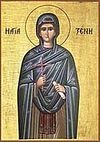

| Previous day | Next day |
| Old Style
May 3
|
Thursday |
New Style
May 16
|
| 3rd Week after Pascha. Tone 2. | No fast.
|
![]() Martyrs Timothy the Reader and his wife Maura, of Antinoe in Egypt (ca. 286).
Martyrs Timothy the Reader and his wife Maura, of Antinoe in Egypt (ca. 286). ![]() St. Theodosius, abbot of the Kiev Caves Monastery and founder of coenobitic monasticism in Russia (1074).
St. Theodosius, abbot of the Kiev Caves Monastery and founder of coenobitic monasticism in Russia (1074).
St. Peter the Wonderworker, bishop of Argos (ca. 928). Translation of the Dormition Icon of the Most Holy Theotokos from Constantinople to the Kiev Caves Lavra (1073). St. Theophanes of Vatopedi, metropolitan of Peritheorion (14th c.). Schema-abbess Juliana (1393) and Schemanun Eupraxia (1394), of the Monastery of the Conception in Moscow. St. Gregory, bishop of Rostov and Yaroslavl (1416).
“Svensk” Icon of the Most Holy Theotokos (1288).
Great-martyr Xenia the Wonderworker, of the Peloponnese (318). St. Ecumenius the Wonderworker, bishop of Tricca (4th c.). St. Mamai, catholicos of Georgia (744). Sts. Michael and Arsenius the Georgians (9th c.). St. Ansfried, bishop of Utrecht (1010). Martyr Paul of Vilnius, Lithuania (17th c.). New Martyr Achmed (Ahmet) the Calligrapher, at Constantinople (1682). St. Irodion, abbot, of Lainici Monastery (Romania) (1900). Martyrs Diodorus and Rhodopianus, deacon, at Aphrodisia in Anatolia (285-305). Finding of the relics of St. Luke of Mt. Steirion (953). Sts. Silas (1783), Paisius and Nathan (1784), monks of Putna Monastery (Moldova).
Thoughts for Each Day of the Year
According to the Daily Church Readings from the Word of God
By St. Theophan the Recluse

039
Thursday. [Acts 8:26–39; John 6:40–44]
Saint Philip asks the eunich: understandest thou what thou readest? He answered: how can I, except some man should guide me? (Acts 8:31). How often those who read the word of God and writings of the fathers experience the same thing! What is read is beyond our comprehension; the mind cannot heed or grasp it, as if it were something foreign to it, about topics of an unknown realm. This is why an interpreter is needed, who is familiar with the meaning of the words. Saint Philip had the same spirit as the one which brought those prophecies, and so it was not difficult for him to interpret what the eunuch found hard to understand. Thus it is for us now: we must find a person who stands on such a level of life and knowledge as is touched upon by the scripture which is difficult for us, and he will interpret it without difficulty, because each level has its own spiritual view. He who stands on a lower level does not see all that he who stands on the higher sees, and can only guess about it. If it happens that the scriptures which are incomprehensible for us touch upon subjects of the higher level, but the interpreter met by us stands on the lower, then he cannot explain it as he should, and will apply everything to his own outlooks, and it will remain for us as dark as before. One must marvel at how people take on interpreting topics of Scripture while being totally foreign to the realm to which these subjects belong. And for them it does not come out as it should; nor do they fail to get puffed up over their own interpretations.
Articles
 Martyr Timothy the Reader and his wife in EgyptSaints Timothy and Maura suffered for the faith during the persecution under the emperor Diocletian (284-305). |
 St. Peter the Wonderworker and Bishop of ArgosSaint Peter the Wonderworker, Bishop of Argos in the Peloponnesos, lived during the ninth and early tenth centuries, and was raised by pious parents. |
 Icon of the Mother of God of SvenThe Sven Caves Icon of the Mother of God was painted by Saint Alypius of the Caves (August 17). |





